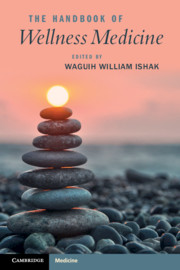Book contents
- The Handbook of Wellness Medicine
- The Handbook of Wellness Medicine
- Copyright page
- Dedication
- Contents
- Contributors
- Part I Approach to Wellness
- Part II From Illness to Wellness by Organ Systems/Disorders
- Part III Special Populations and Special Topics
- Part IV Wellness Interventions
- Chapter 22 Nutrition
- Chapter 23 Nutraceuticals and Wellness
- Chapter 24 Pharmaceuticals and Alternatives for Wellness
- Chapter 25 Exercise, Dance, Tai Chi, Pilates, and Alexander Technique
- Chapter 26 Sleep, Rest, and Relaxation in Improving Wellness
- Chapter 27 Sex, Intimacy, and Well-Being
- Chapter 28 Mindfulness, Meditation, and Yoga
- Chapter 29 Forgiveness, Gratitude, and Spirituality
- Chapter 30 Positive Neuropsychology, Cognitive Rehabilitation, and Neuroenhancement
- Chapter 31 Acupuncture, Herbs, and Ayurvedic Medicine
- Chapter 32 The Role of Aesthetics in Wellness
- Chapter 33 Massage, Humor, and Music
- Chapter 34 Nature and Pets
- Chapter 35 Circadian Rhythm in the Digital Age
- Chapter 36 The Arts in Health Settings
- Chapter 37 Engaging the Five Senses
- Chapter 38 Emotional Intelligence and Its Role in Sustaining Fulfillment in Life
- Chapter 39 Psychotherapy and Positive Psychology
- Chapter 40 Resilience and Wellness
- Chapter 41 Developing Purpose, Meaning, and Achievements
- Chapter 42 Healing and Wellness
- Chapter 43 Connection, Compassion, and Community
- Chapter 44 Wellness Interventions for Chronicity and Disability
- Part V Wellness through Optimization of Work, Love, and Play
- Book part
- Index
- References
Chapter 33 - Massage, Humor, and Music
from Part IV - Wellness Interventions
Published online by Cambridge University Press: 18 September 2020
- The Handbook of Wellness Medicine
- The Handbook of Wellness Medicine
- Copyright page
- Dedication
- Contents
- Contributors
- Part I Approach to Wellness
- Part II From Illness to Wellness by Organ Systems/Disorders
- Part III Special Populations and Special Topics
- Part IV Wellness Interventions
- Chapter 22 Nutrition
- Chapter 23 Nutraceuticals and Wellness
- Chapter 24 Pharmaceuticals and Alternatives for Wellness
- Chapter 25 Exercise, Dance, Tai Chi, Pilates, and Alexander Technique
- Chapter 26 Sleep, Rest, and Relaxation in Improving Wellness
- Chapter 27 Sex, Intimacy, and Well-Being
- Chapter 28 Mindfulness, Meditation, and Yoga
- Chapter 29 Forgiveness, Gratitude, and Spirituality
- Chapter 30 Positive Neuropsychology, Cognitive Rehabilitation, and Neuroenhancement
- Chapter 31 Acupuncture, Herbs, and Ayurvedic Medicine
- Chapter 32 The Role of Aesthetics in Wellness
- Chapter 33 Massage, Humor, and Music
- Chapter 34 Nature and Pets
- Chapter 35 Circadian Rhythm in the Digital Age
- Chapter 36 The Arts in Health Settings
- Chapter 37 Engaging the Five Senses
- Chapter 38 Emotional Intelligence and Its Role in Sustaining Fulfillment in Life
- Chapter 39 Psychotherapy and Positive Psychology
- Chapter 40 Resilience and Wellness
- Chapter 41 Developing Purpose, Meaning, and Achievements
- Chapter 42 Healing and Wellness
- Chapter 43 Connection, Compassion, and Community
- Chapter 44 Wellness Interventions for Chronicity and Disability
- Part V Wellness through Optimization of Work, Love, and Play
- Book part
- Index
- References
Summary
Massage is the therapeutic manipulation of the body’s soft tissue in a patterned and purposeful way [1]. It is a form of healing, with various ancient civilizations, including Egyptian, Chinese, Indian, and Greek, developing different systems of massage throughout history. Modern Western massage therapy can trace its roots to two Europeans, Pehr Henrik Ling (1776–1839) of Sweden, who developed Swedish massage techniques, and Johann Mezger (1838–1909) of Amsterdam, who invented a system of soft tissue manipulation known as remedial massage [2].
- Type
- Chapter
- Information
- The Handbook of Wellness Medicine , pp. 403 - 412Publisher: Cambridge University PressPrint publication year: 2020



